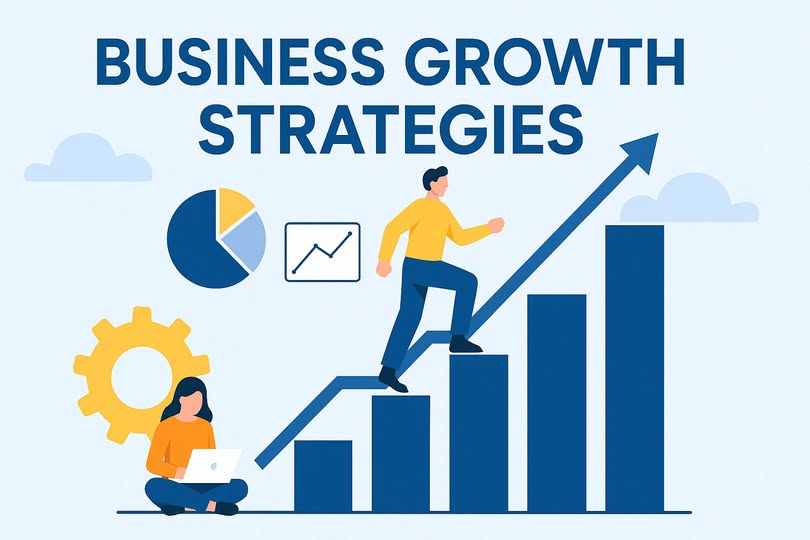Let’s get one thing straight. “Growth hacking” is a buzzword, not a strategy. Chasing viral moments is like trying to bottle lightning, it’s exciting if it happens, but it’s a terrible plan for building a business that lasts. I’ve seen countless companies burn through cash chasing fleeting trends, only to fizzle out.
Real, sustainable growth isn’t about luck. It’s about engineering. It’s about building a machine that predictably generates results, whether the market is up or down. You don’t need a massive venture capital check; you need a smarter blueprint.
Remember, every business whether an ambitious startup or a well-established corporation—faces a pivotal question: how can we achieve growth that truly lasts? Rapid expansion without a strong foundation can lead to instability, while stagnant operations open the door for competitors to take over. Sustainable growth acts as the engine of long-term success, enabling companies to scale efficiently, reinvest in innovation, and strengthen brand equity that compounds over time. In today’s digital era, mastering digital marketing strategies and consistent brand awareness building are essential components for driving meaningful, measurable, and lasting business growth.
Sustainable growth is not about reckless scaling; it’s about steady, strategic advancement. It requires that you optimize existing operations, protect cash flow, invest in people and systems, and consciously expand capacity without overextending. That is why sound business growth strategies are essential: they provide a roadmap, help you allocate resources, guide decision-making, and ensure that expansion is aligned with your mission and market realities.

In practice, the strongest firms combine multiple growth levers in concert. For example: a local USA or Canadian e-commerce brand might begin by deepening market share in Dhaka through localized promotions, then launch new product categories, before finally exporting to neighboring countries. Globally, companies like Apple layer product innovation, pricing, partnerships, and technology adoption to widen profit margins and lock in customer loyalty. These success stories all rest on well-defined and executed business growth strategies.
I’m going to lay out the exact strategic framework that separates businesses that thrive for decades from those that are a flash in the pan. Forget the surface-level tactics. We’re diving into the core principles that create lasting momentum and market domination.
In this article, we’ll define What is a Business Growth Strategy?, explore 12 major business growth strategies in depth (with practical guidance), present real examples, and conclude with keys to sustainable expansion plus actionable takeaways.
What Is a Business Growth Strategy?
A business growth strategy is a deliberate and structured plan that defines how a company aims to expand and sustain success over time. It maps out the specific pathways to increase revenue, capture market share, enhance profitability, and strengthen competitive advantage. Essentially, a growth strategy acts as a roadmap guiding when to invest, when to scale, and when to innovate. In today’s competitive digital landscape, integrating powerful content marketing strategies within your growth framework can help attract the right audience, build trust, and accelerate measurable business expansion organically.
Key aspects of a growth strategy include:
- Objectives and metrics: What does growth mean for this business? Is it revenue increase, profit margins, number of customers, geographic reach, or all of the above?
- Growth levers and tactics: Which strategic approaches will be used (e.g., product expansion, market development, technology upgrades)?
- Resource allocation: Which functions—R&D, marketing, operations—get how much investment?
- Sequencing and timing: In what order should initiatives be launched, tested, scaled, or pruned?
- Risk management: Which moves require safeguards, contingency plans, or pilot testing?
- Feedback loops: How will you collect data and iterate your strategy over time?
Without a growth strategy, companies often drift—reacting to external pressures or copying competitors without coherence. A clear growth framework lets you choose when to push ahead and when to consolidate. In sum, a business growth strategy is the blueprint for scaling operations, expanding reach, and making growth sustainable and defensible.
The 12 Major Business Growth Strategies
Below are twelve powerful growth strategies. You need not (and often should not) pursue all of them at once but understanding each gives you options and helps you design a portfolio of tactics suited to your business stage and resources.
1. Market Penetration
Market penetration focuses on selling more of your existing products or services within your current markets. It’s one of the most fundamental and least risky business growth strategies because it leverages what already works. Instead of developing new products or expanding geographically, businesses aim to increase their share of the existing market through smarter marketing, customer engagement, and value delivery. The emphasis lies in deepening relationships with current customers, outpacing competitors, and ensuring your product becomes the preferred choice. Companies that master market penetration often dominate their industries through persistence, branding, and precision.
Tactics & Practical Tips
- Launch targeted promotions, loyalty programs, and referral incentives.
- Improve distribution channels and retail visibility.
- Use personalized marketing to boost repeat purchases.
- Optimize pricing and bundle complementary products.
- Strengthen customer support and brand experience.
Example: Coca-Cola continuously reinforces its dominance through emotional branding, sponsorships, and consistent global messaging, ensuring repeat purchases and deep customer loyalty.
2. Product Development
Product development is about innovating or enhancing existing offerings to satisfy changing consumer demands. It allows companies to capture new segments within their existing markets by adding value, convenience, or new experiences. This strategy keeps brands relevant in dynamic industries like technology, consumer electronics, and fashion. Effective product development begins with research—understanding customer pain points and anticipating future needs. It’s one of the most creative business growth strategies, combining innovation with customer insight to strengthen competitiveness and brand equity.
Tactics & Practical Tips
- Conduct user research and market testing before full-scale launches.
- Improve existing features or introduce premium versions.
- Offer complementary accessories or digital upgrades.
- Collaborate with customers to co-create products.
- Continuously innovate to stay ahead of competitors.
Example: Apple demonstrates perfect execution of product development by evolving from the iPod to the iPhone to the Apple Watch, setting industry standards with every iteration.
3. Market Expansion
Market expansion also known as market development involves introducing existing products into new geographic, demographic, or psychographic markets. It’s ideal for businesses that have achieved strong local saturation and are ready to reach untapped customers elsewhere. This approach helps diversify risk and leverage brand equity on a larger scale. It’s among the most strategic business growth strategies, requiring deep cultural understanding, competitive research, and localized marketing. When executed well, it positions a brand as a global force rather than a regional player.
Tactics & Practical Tips
- Identify new countries or regions with high growth potential.
- Localize marketing messages and product features.
- Partner with local distributors or franchisees.
- Adapt packaging, pricing, and communication for local preferences.
- Study regional regulations and consumer behaviors carefully.
Example: Netflix expanded from the U.S. to over 190 countries by investing in localized content like “Money Heist” and “Squid Game,” ensuring relevance and loyalty worldwide.
4. Strategic Partnerships
Strategic partnerships allow companies to share resources, technology, and expertise for mutual growth. This is one of the smartest business growth strategies to make partnership because it combines strengths without requiring heavy capital investment. Through collaboration, companies gain access to new customers, markets, and innovations that would otherwise be costly or time-consuming to achieve independently. Partnerships can range from co-branding deals to joint ventures and technology integrations each unlocking fresh growth potential.
Tactics & Practical Tips
- Partner with complementary businesses to expand market reach.
- Form joint ventures to enter new industries or regions.
- Share R&D costs for innovative product development.
- Launch co-marketing campaigns to maximize exposure.
- Use affiliate programs or distribution alliances strategically.
Example: Starbucks partnered with PepsiCo to distribute bottled coffee globally, leveraging PepsiCo’s logistics and distribution power to reach new customers.
5. Customer Retention
Customer retention emphasizes keeping your existing clients satisfied and engaged so they continue to buy and recommend your products. It’s significantly more cost-effective than constant customer acquisition. This customer retention strategy revolves around building emotional connections, enhancing value, and providing memorable experiences. Retaining loyal customers ensures stable cash flow, brand advocacy, and long-term growth. It’s not merely about repeat purchases; it’s about cultivating trust and consistency that turn customers into lifelong fans.
Tactics & Practical Tips
- Introduce loyalty and rewards programs.
- Offer subscription or membership models for convenience.
- Provide superior after-sales support and personalized service.
- Use CRM systems to track satisfaction and preferences.
- Send follow-up surveys and feedback forms for continuous improvement.
Example: Amazon Prime drives exceptional retention by combining fast shipping, streaming services, and exclusive deals under one subscription, locking customers into its ecosystem.
6. Competitive Pricing
Competitive pricing is a strategy where businesses set prices based on market conditions and competitor benchmarks to attract more customers. It’s one of the most tactical business growth strategies, balancing value perception and profitability. Smart pricing not only drives sales volume but also signals brand positioning—affordable for the masses or premium for exclusivity. The right pricing strategy can differentiate you in a crowded market, allowing growth through precision rather than volume.
Tactics & Practical Tips
- Use penetration pricing for new market entry.
- Apply dynamic pricing with real-time data analytics.
- Bundle products for perceived value.
- Create psychological pricing (e.g., $9.99 vs $10).
- Test A/B pricing to determine optimal points.
Example: Ryanair and Southwest Airlines use low-cost pricing models to democratize air travel, while Apple leverages premium pricing to elevate perceived value.
7. Digital Marketing
In the digital age, marketing has evolved from traditional advertising to algorithmic precision. Digital marketing encompasses SEO or search engine optimization, content marketing, social media, email automation, and paid media to drive measurable business results. It’s one of the most essential modern business growth strategies, offering scalability and data-driven optimization. By creating valuable content and building online authority, businesses can attract, engage, and convert audiences globally—all while reducing marketing costs compared to traditional methods.
Tactics & Practical Tips
- Optimize websites for SEO and mobile experience.
- Create valuable content (blogs, infographics, videos).
- Run data-driven campaigns on Google and social media.
- Use marketing automation to nurture leads.
- Leverage influencer partnerships for credibility.
Example: Nike’s “Just Do It” digital storytelling campaigns inspire emotional engagement and global visibility through consistent branding across online channels.
8. Exploring New Markets
Exploring new markets involves venturing into industries or customer segments previously untouched by your business. Unlike market expansion (geographical), this strategy focuses on diversification—leveraging existing strengths to enter new verticals. It’s among the more advanced business growth strategies, requiring risk tolerance and vision. The goal is to unlock new revenue streams by applying your expertise in innovative ways or complementary industries.
Tactics & Practical Tips
- Research emerging sectors aligned with your core strengths.
- Test entry via pilot projects or small investments.
- Acquire startups with established market presence.
- Rebrand existing products for new customer segments.
- Use cross-industry collaborations to fast-track entry.
Example: Tesla expanded beyond electric cars into solar panels and battery storage, transforming itself from an automaker into a clean-energy powerhouse.
9. Expanding New Product Lines
Expanding into new product lines helps diversify risk and strengthen market presence. By offering related or entirely new products, businesses attract new customers while deepening relationships with existing ones. It’s a proven method among established business growth strategies, ensuring long-term sustainability. The key is to align expansion with your brand’s vision and operational capacity, so quality and identity remain consistent across all offerings.
Tactics & Practical Tips
- Identify adjacent product opportunities.
- Use existing infrastructure for new production.
- Introduce limited editions to test demand.
- Bundle complementary products for higher value.
- Cross-sell across different product categories.
Example: Amazon started as a bookstore but evolved into a multi-product marketplace and cloud leader through Amazon Web Services (AWS), expanding profitability exponentially.
10. Employee Development
Employee development focuses on nurturing talent through training, mentorship, and upskilling. Your workforce is the foundation of every successful company. Investing in their growth improves innovation, performance, and retention—directly impacting productivity and profitability. Companies adopting this as one of their business growth strategies understand that people create competitive advantage, not just products or processes. Empowered employees lead to creative solutions, better customer interactions, and long-term loyalty.
Tactics & Practical Tips
- Provide leadership and technical training programs.
- Encourage a culture of continuous learning.
- Offer career growth opportunities and mentorship.
- Reward innovation and initiative through incentives.
- Promote cross-department collaboration for skill diversity.
Example: Google invests in internal learning programs and innovation time, allowing employees to experiment—resulting in products like Gmail and Google Maps.
11. Customer Feedback and Insights
Customer feedback is the compass that guides sustainable growth. It reveals what works, what doesn’t, and where innovation is needed. Among all business growth strategies, this one ensures your direction aligns with market demand. By systematically collecting and analyzing feedback, companies can refine products, personalize experiences, and build trust. In an era driven by data, feedback is the bridge between assumption and action.
Tactics & Practical Tips
- Conduct NPS surveys and customer interviews.
- Analyze behavioral data from apps or websites.
- Track online reviews and social sentiment.
- Implement CRM systems for deeper insights.
- Close the loop by acting on feedback promptly.
Example: Netflix uses sophisticated algorithms and user data to recommend content and guide production decisions, improving satisfaction and retention globally.
12. Adopting New Technology and Innovation
Adopting new technology is one of the most transformative business growth strategies. Innovation allows companies to enhance efficiency, reduce costs, and create entirely new markets. Technology isn’t just a tool—it’s a growth catalyst that redefines how value is created and delivered. From automation and AI to cloud computing and analytics, modern technology enables smarter operations, predictive insights, and scalable infrastructure that can future-proof your business.
Tactics & Practical Tips
- Implement automation tools to streamline workflows.
- Integrate AI for smarter decision-making.
- Use cloud systems for scalability and collaboration.
- Explore IoT, blockchain, or AR for innovation.
- Foster an internal culture that embraces digital change.
Example: IBM transformed from a hardware manufacturer into a cloud and AI pioneer by investing in data analytics and automation-driven services.
Growth Strategy Examples: Global Lessons
- Apple integrates product innovation, brand excellence, and ecosystem lock-in to create customer loyalty.
- Amazon combines market penetration, digital marketing, and diversification into AWS for exponential scaling.
- Tesla blends technology adoption and market expansion to dominate the clean energy revolution.
- Unilever excels at market localization and sustainability-driven growth.
- Netflix showcases data-led personalization and content innovation as cornerstones of retention.
Engineer a Resilient Business Model
Fast growth is exciting. Resilient growth is powerful. A resilient business can withstand economic downturns, pivot with market shifts, and thrive while others struggle.
Diversify Your Revenue Streams
Relying on a single product or a handful of clients is a massive risk. You’re one market shift away from being obsolete.
- Create Product Tiers: Offer “Good, Better, Best” versions of your solution to capture customers at all price points.
- Add Adjacent Services: If you sell software, offer premium implementation, training, or consulting services.
- Embrace Recurring Revenue: Convert one-time sales into subscriptions. Adobe’s move from selling Creative Suite to the monthly Creative Cloud subscription created a predictable, defensible revenue machine.
Obsess Over Your Unit Economics
You must know your numbers inside and out. The two most important metrics for sustainable growth are Customer Acquisition Cost (CAC) and Customer Lifetime Value (LTV).
- CAC: How much does it cost you in sales and marketing to acquire one new customer? (Total Sales & Marketing Spend / Number of New Customers).
- LTV: How much total profit can you expect from a customer over their entire relationship with your business?
The golden ratio is an LTV:CAC of at least 3:1. If you spend $1 to acquire a customer, they should generate at least $3 in profit. If your ratio is 1:1, you’re on a treadmill to nowhere. If it’s 5:1, you’re not investing enough in growth.
The Key to Growing Your Business
Sustainable business growth is not about doing everything, it’s about doing the right things consistently. Success lies in balancing risk and innovation, leveraging data-driven insights, and nurturing long-term relationships. The most effective companies adapt continuously, stay customer-focused, and align every department with a unified growth vision.
Growth requires patience, discipline, and creativity. By integrating these business growth strategies from market penetration to technological innovation that you build not just a profitable company, but a brand that evolves and endures.
Key Takeaways
- Definition: Business growth strategies are structured frameworks that guide sustainable expansion.
- Twelve Strategies: Market penetration, product development, market expansion, partnerships, customer retention, competitive pricing, digital marketing, exploring new markets, expanding product lines, employee development, customer feedback, and technology innovation.
- Global Insight: Companies like Apple, Amazon, and Tesla demonstrate the power of combining multiple strategies cohesively.
- Focus on Sustainability: Growth without strategy is temporary—long-term success demands adaptability, innovation, and execution excellence.


